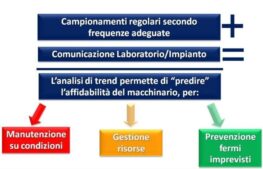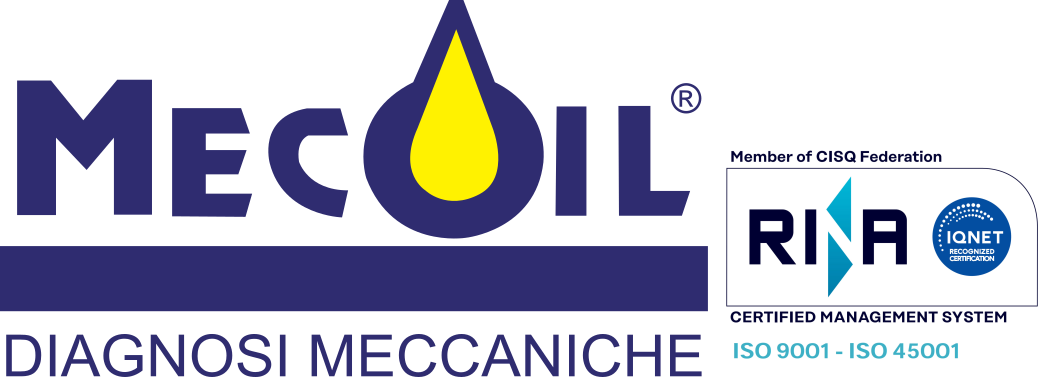“Why analyze the oil?” is a relevant question. For the operators of a plant, it is a legitimate request for clarification: for themselves in the first place, and for those who come to propose a similar”assessment”activity within their assets. When it comes to condition monitoring, the use of Predictive Maintenance methods, including used oil analyses, is a need that has developed over time, after the introduction of management doctrines that took into account topics related to Quality and Safety, among others. After the heroic phase of post-war reconstruction/renewal, around the 1980s logical/political processes were launched that transformed the perception of the industrial environment, such as production, efficiency and profitability. The commissioning phase (after the more theoretical/design part) puts more attention on the “tiny details” that lead to important advances in terms of reliability. This is true in the industrial world, but also in the field of transportation and all the many production activities, where simply “doing” no longer meets the demand. Here is where the competent technician discovers new functionalities of the equipment that were once difficult, with which to proceed to accurately align or balance pieces that rotate at high speeds. If well flanged and positioned, a pump (with its bearings) is less noisy, and therefore dispels less energy and the “message” it sends to the surrounding world is a calm one. We discover that the “adverse fatalities” are actually a mix of improvisation (for example, sizing errors or compatibility issues) and poor attention to detail (such as the initial cleanliness of the components).
For dynamic/rolling components, the reference technique thus becomes the measurement of vibrations and acoustics in a broad sense. Accelerometers, “spike” meters or ultrasound machines are refined diagnostic systems capable of quantifying the “noise” by comparing it with analytical archives in order to formulate guidelines. With the increase of criticality and demandingness of the components (greater speed, load, reduction of encumbrances) we find that the traditional alignment with the “brackets” is no longer sufficient. Or maybe the staff has lost those skills (legacy of traditions and past experiences) that were once taken for granted. It is therefore essential to use “assisted” systems (laser alignment) or get outsourced assistance from specialists.
What about the lubricant?
We have seen that we can resort to different diagnostic investigation techniques to prevent (predict and manage) mechanical damage in rotating machines (non-destructive tests that can also be applied in other industrial fields); on the other hand, monitoring the operating conditions of a lubricant is often neglected, except when facing a concrete problem. Essentially, only in the presence of a serious anomaly, sometimes even a functional failure, the plant operator starts to wonder how much of its “prime causes” can be attributed to the lubricant used. The response expected (in this phase it is essential to obtain the endorsement from a specialized laboratory) is inherent to the intrinsic quality of the product used, when new, in terms of compliance with the mandatory specifications dictated by the manufacturer of the machinery. We investigate the possible fraud against the user, trying to pin the guilt for the shortcomings on someone: “Who made the mistake, will pay!”. Those familiar with such arguments find it very easy to tear down this system of accusations. The cause-and-effect chain of damage is very difficult to reconstruct in logical and irrefutable terms; the oil that circulated within the mechanism, as a result of the damage, has undergone numerous and substantial alterations that make it a “unreliable witness”. It often happens (too often, unfortunately) that we have to listen to long phone tirades from customers who complain about the inadequate performance of seemingly superb products. Very often, their flood of words stops when faced with simple questions such as:
“How many hours has the lubricant been in use for?”
“What kind of filtration was present in the system?”
As we mentioned in the premise, a “noisy” rotating machine probably means something is not working optimally. If you could touch it with your hand (or better, if you had a thermographic image) you would discover “hot spots” as a symptom of not-optimal operation, possible predictions of future damage. In the presence of lubricating oil, or even more with grease lubrication, the “detectable noise” is strongly dampened, almost silenced. But with the most suitable tools, the evidence of the event (even if confined to limited contexts and not easily reachable) does not lose meaning: we only need to be able to “read the phenomenon”.
Let’s Talk Diagnostics
In a modern industry there are a multitude of types of machines: some are particularly complex and are the result of the customization required by the specificity of the various processes in progress. However, their types can be traced back to a few main categories, among which we find: Compressors (volumetric and dynamic), Gears and reducers (connected to agitators, extruders, or simple gearboxes), Turbines, Generators and Pumps, as well as hydraulic control units for monitoring, molding and handling the work centers, and so on. All these machines are sometimes lubricated through very complex circuits, under pressure, or with splash systems, with or without filtration. The history (we could say “the secret life”) of these equipment remains confined within each one, and is preserved in the form of those infinitesimal transformations and contaminations that the oil undergoes while daily lubricating all their nooks and crannies. They are weak signals, sometimes barely detectable through very sophisticated instruments, capable of appraising even a few ppm (parts per million or grams per ton of oil) of metals or to distinguish the level of contamination according to ISO or NAS codes. The evaluation of this analytical data (as an absolute, or as a change in time in percentage, the so-called trend) allows us to formulate precise diagnoses on the health status of the main components and to decide with considerable notice how and when to intervene in order to prevent mechanical damage. The parallel with human physiology and the multiple functions performed by the circulating blood is very evident. Just as for a serious project of preventive medicine, recourse to clinical diagnostics is essential, so are the analytical results emerging from a sample of oil subjected to routine tribological checks, in order to make all the preventive and corrective decisions that are really necessary for the current maintenance. During the phase of running in and settling, after a sharp initial surge, the parameters related to the release of metallic particulates decrease, up to the physiological limits; something similar also happens with some chemical and physical parameters, such as viscosity and the presence of additives. The situation is quite different when we are close to a mechanical failure. Thanks to the identification of some altered indicators, it is possible to formulate a precise diagnosis on the residual useful life of the machinery and lubricant under investigation. For each type of component of the production cycle, there are specific analytical signals that need to be carefully monitored in order to better direct the preventive intervention.


by Alessandro Paccagnini,
extract from Maintenance edition February 2011
